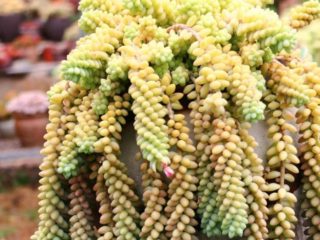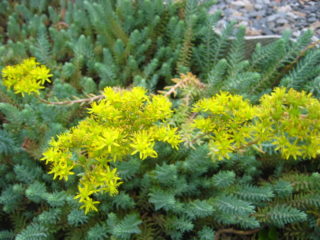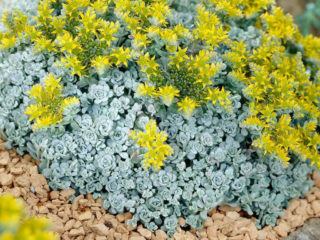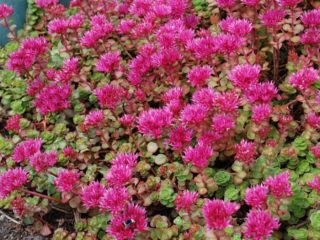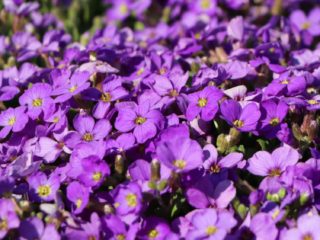Content
Sedum caustic is an unpretentious ornamental plant that diversifies flower arrangements in garden beds or in a city park. The plant develops rapidly and begins to bloom regardless of the fertility of the soil. The main thing is to put it in a well-lit place.
Description of Caustic Sedum
Sedum caustic, or Sedum acre (lat.) - melliferous herbaceous perennial. It is a semi-succulent plant. Has thickened sheet plates.
Succulents (Latin succulentus - juicy) are distinguished by the presence of tissues to create a supply of fluid. This feature allows them to survive in areas with poor rainfall.
Sedum is a species of the genus Sedum. Represents the family of dicotyledonous plants - Tolstyankovs (lat. Crassulaceae).
Sedum is a stunted species. It has a thin rhizome with branches and many stems with small thickened light or dark green ovoid leaves.
This type of root system allows the plant to be saturated with moisture. During the dry season, the roots are shown on the surface to feed with dew and raindrops.
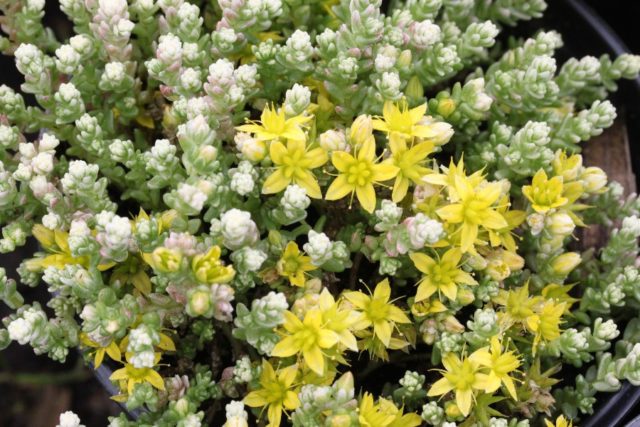
The sedum is found on sandy slopes, forest edges and clearings
The shade of the leaf plates depends on the illumination of the place where the perennial grows. Phenotypic features of stonecrop are less intense color of leaves, lack of flowering in the shade. In the sun, the plant has dark leaves, yellow fragrant flowers, collected in inflorescences. Stonecrop head consists of five petals and ten stamens. Flowering continues from late spring to mid-summer. During this period, the leaves also turn yellow.
The habitat of sedum caustic:
- dry areas of sandy soils;
- glades;
- edges of the forest;
- embankments;
- limestone;
- slopes with stones;
- brick surfaces;
- ridges and fields of cultural plantings.
Growing regions - North Africa, Europe, Ciscaucasia, Western Siberia and the European part of the Russian Federation.
The best varieties
Stonecrop genus includes 600 species of plants. Today, specialists and amateur gardeners are engaged in breeding and growing about 100 species. Each has many varieties. They differ in the shade of greenery and flowers. The most attractive are used for landscaping areas.
Elegans
A perennial of the Elegans variety reaches 10 cm in height, and during the flowering period it grows up to 30 cm. It has branched stems with thick twisted leaves of a dark green hue up to 0.6 cm long. It is covered with leaves in winter. Inflorescences consist of golden heads up to 1.5 cm in diameter. Stonecrop blooms from June to mid-July. It is similar to the Aureum variety, but more miniature.
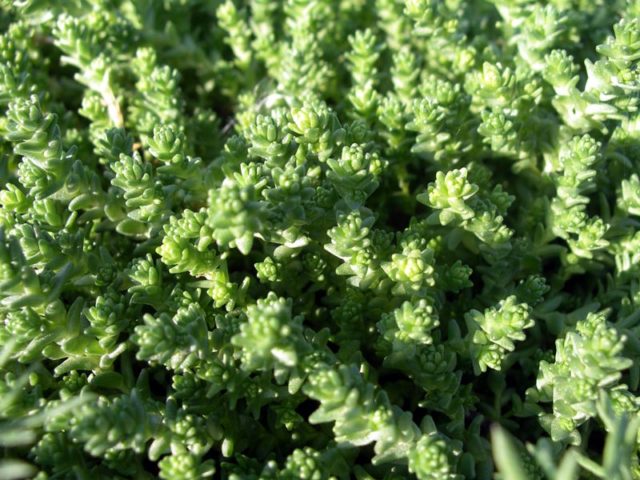
The "Elegance" variety has abundant flowering lasts 2 months
Grows on any soil. Grows well on rocky surfaces, suitable for container planting. It tolerates dry periods and frosts well. Forms a continuous carpet in the garden area, favorably emphasizes tall plants.
When grown in the middle lane, sedum "Elegance" does not need shelter for the winter. The frost resistance of the variety is up to -34 ° C.
Aureum
Bushes of the variety "Aureum" (Aureum) grow up to 8 cm. The upward-striving stems are covered with small thickened leaves. Shoots located close to the surface of the soil release adventitious roots. The plant is decorated with inflorescences of yellow heads. "Aureum" blooms from May to July. Stonecrop leaves also turn yellow at this time.
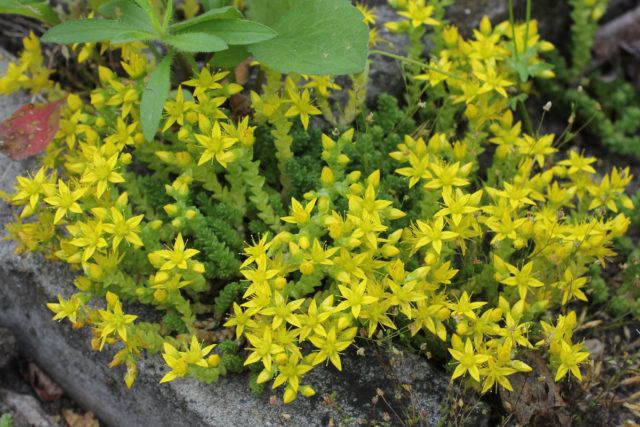
"Aureum" is an adornment of alpine slides and rockeries
It grows and develops fully even on poor soils. On the garden plot "Aureum" will decorate alpine slides and rockeries.
Minus
Variety "Minus" (Minus) - decorative type of sedum. Bushes are low, up to 10 cm. The leaves are thickened, gray-green, cylindrical in shape. Under the influence of ultraviolet light, the tops of the leaf plates acquire a pink tint.
Photo of sedum caustic "Minus" illustrates the original color of its greenery.

Under the influence of UV rays, the leaf tops of the Minus cultivar acquire a pink hue
Application in landscape design
The sedum will decorate and diversify the landscape of a garden plot or flower beds of a city park. The plant can be planted separately to create an even cover or supplemented with floral arrangements. As it grows, the semi-succulent will cover the bare areas of the lawn with its crown and flowers, help to effectively decorate the border or borders of the garden pond. Long hanging stems of "Sedum of Caustic" will look harmonious in hanging baskets.

Acrid sedum thickets serve as a spectacular design for the border of the flower bed
Breeding features
Under favorable conditions, the honey plant grows rapidly.
Breeding methods:
- seeds;
- cuttings;
- division of bushes.
Generative (seed) propagation is used to create new varieties. For rapid spreading, dividing mature bushes or grafting is more suitable.
The seeds can be placed in seedling containers in March-April. The material is distributed over fertile soil, covered with a layer of sand and covered with a special device or glass.
Young specimens of caustic sedum are placed in a cool, ventilated room and regularly sprayed with water. After 14 days, the containers are transferred to a warmer place. The sprouts are shown in a month. A dive is performed with the appearance of two leaves.
Before planting in open ground, sedum seedlings are periodically taken out into fresh air for hardening. When grafting, a fragment of the stem must be cut off and planted in a substrate or first placed in water to form roots.
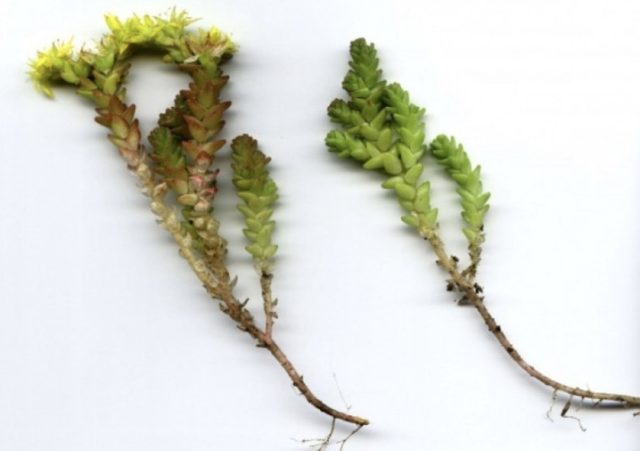
Shoot for planting can be cut with a sharp knife
The division of an adult plant is carried out in the spring. To do this, the bush is dug up and the roots are taken apart. Young plants with buds and roots are planted shortly after cutting.
Optimal growing conditions
On the site for cleaning caustic, it is better to choose a sunny place. Instances planted in a darkened area do not bloom. Sedum will flower and have strong leaves only in good light. Otherwise, the stems will lengthen, and sedum will lose its decorative effect.
Planting and caring for caustic sedum
In order for the honey plant to grow quickly and gain strength, it is important to plant mature bushes on time and prepare the substrate in a sunny place on the site.
Recommended timing
Sowing seeds is carried out in early spring in March-April. Cuttings and planting of new specimens are carried out before or after the end of flowering. They quickly "master" in the chosen place. It is possible to separate adult plants in order to rejuvenate the plantation and plant new ones in spring or early autumn, so that the bushes have time to take root.
Site selection and soil preparation
"Sedum caustic" is a light-loving culture.The stems and leaves will have a rich green color, and the inflorescences will become large and bright if you choose a sunny place for planting the semi-succulent. Also, the bed can be in partial shade.
Algorithm of planting caustic sedum
Seedlings are planted in open ground in a sunny area in late spring or early summer. The distance between the holes should be 20 cm for the free formation of new shoots. The planting site is fertilized with ash and sand is added. Blooming of young bushes begins in 2-3 seasons.
Cuttings of "Sedum caustic" can be stored for a long time. Even dry parts germinate. They can be planted throughout the warm season.
Care for caustic sedum
Sedum is caustic, or sedum does not need careful maintenance and grows quickly, forming an even natural carpet.
A rich soil composition is also a prerequisite for the successful growth of a semi-succulent. But a light fertile, super-sandy or moderately acidic soil is especially suitable for the plant.
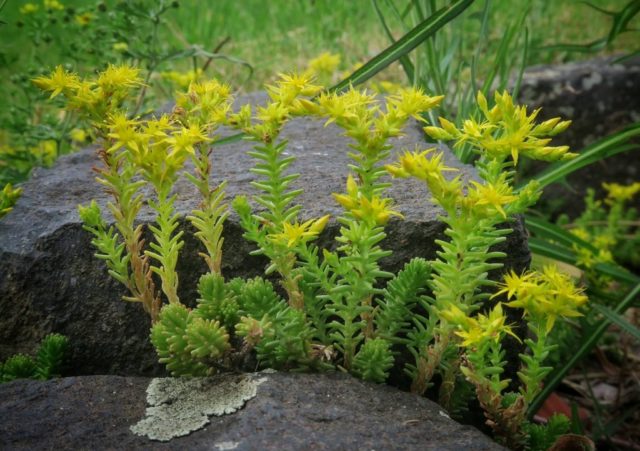
Sedum caustic often changes the color of the leaves with a lack of sunlight and frequent feeding
When growing "Sedum caustic" at home, you need to wipe the dust from the surface of its leaf plates for better light access. If the sedum grows in the garden, you need to remove the fallen leaves from it so that in the spring the honey plant can begin to grow unhindered.
Watering and feeding
Complex mineral compositions or organic matter can be used as fertilizers for cleaning caustic matter. Top dressing is carried out in spring and autumn. Manure is diluted with water in a ratio of 1 to 10. If poultry droppings are used, then 1 to 20.
Top dressing with nitrogen fertilizer activates growth, but the plants become weak, less protected from diseases and low temperatures.
If the sedum grows in a climate with moderate rainfall, it does not need to be watered. But during dry periods, a semi-succulent plant needs additional moisture.
Loosening and weeding
Young plantings need to be loosened so that air flows to the roots and the soil does not sour. Adult specimens should also be loosened and weeded out.
Pruning
Sedum pruning is done in order to rejuvenate the plant and make it aesthetically pleasing. This can be done during the entire warm season, from spring to autumn. If the plantation has grown a lot, stonecrop leaves become pale, and flowering is scarce - it's time to prune the bushes, remove dry stems and sluggish flowers. Also, the aboveground part is cut off for the winter.
Wintering
In areas with snowy winters, stonecrop does not need shelter. The exception is young specimens. Fallen leaves, spruce branches or special material can be used as protection against frost. Adult specimens remain green even under a layer of snow.
Transfer
Stonecrop bushes must be renewed every 3-4 years. To do this, in spring or autumn, the plants are divided into several parts and planted on a prepared bed.
In early spring, stonecrops need to be dug up, the roots removed from the earth and divided into parts. Each process must have buds and roots. The sections should be treated with a fungicide and the new plants should be placed in a cool, dark place to dry. Then they are planted in a prepared substrate.
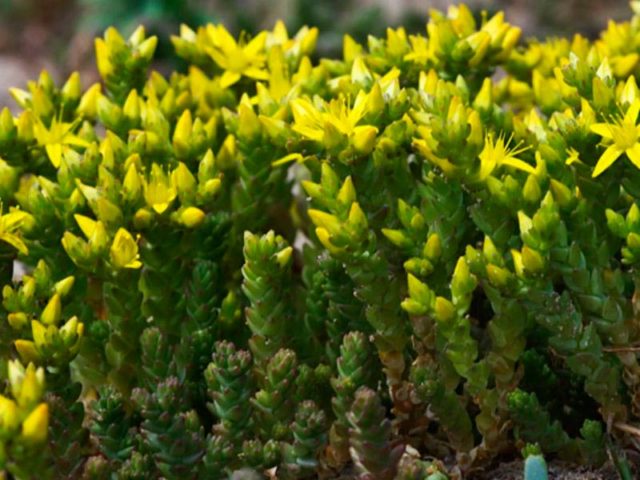
Caring for caustic stonecrop includes watering, feeding, pruning, loosening and weeding
Pests and diseases
Sedum caustic is a plant that is resistant to diseases, but if the soil is waterlogged, then rot may appear. In this case, the affected areas must be removed, and the healthy stems must be treated with a disinfectant.
If aphids, thrips or other pests appear on the bushes, insecticides should be used.
The greatest danger to sedum is nematodes.
Signs of damage to stonecrop by nematodes:
- wilting of the stems;
- slow growth;
- thickening on the rhizome.
You need to plant garlic or marigolds on the vacated area of the garden.
Healing properties
Sedum caustic refers to medicinal plants. It contains valuable substances:
- sedamine (alkaloid);
- glycosides;
- flavones.
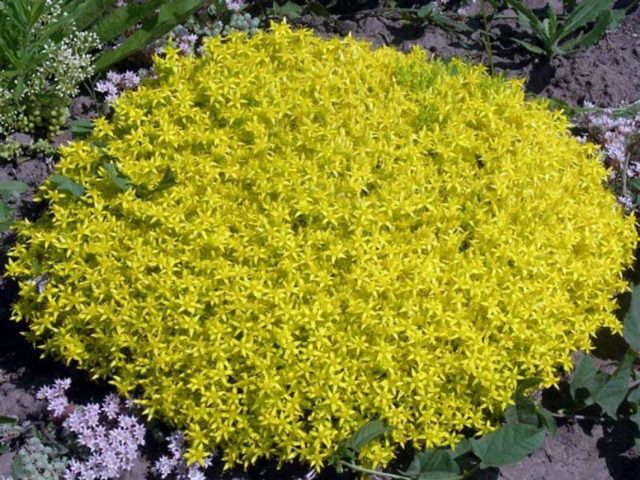
Decoctions and ointments with caustic stonecrop are used to treat skin diseases
Infusion of semi-succulent herb tones up the nervous system, has a constricting effect on blood vessels, helps to raise blood pressure, and stimulates the digestive tract. Flavone has a pronounced diuretic effect. In Bulgarian medicine, sedum is used for hypotension.
Conclusion
Sedum caustic is an ornamental plant that does not require careful maintenance, grows quickly and blooms profusely. The semi-succulent plant is notable for its original leaves and golden yellow flowers. It is resistant to frost and disease. Observing the simple rules of planting and care, you can decorate the landscape with an outlandish plant that will delight gardeners with fresh greens all year round.


